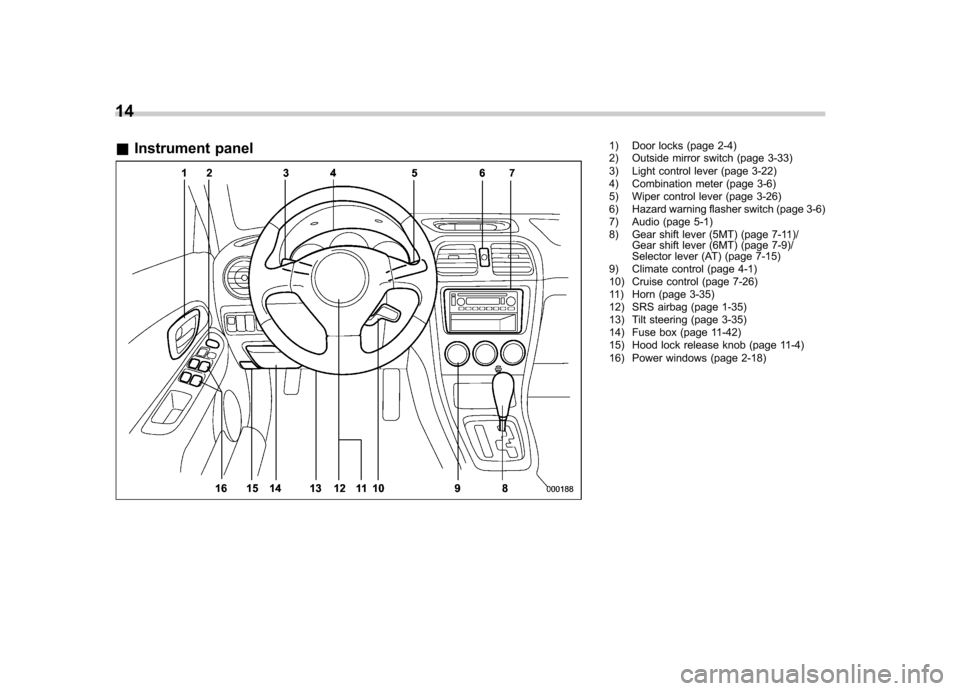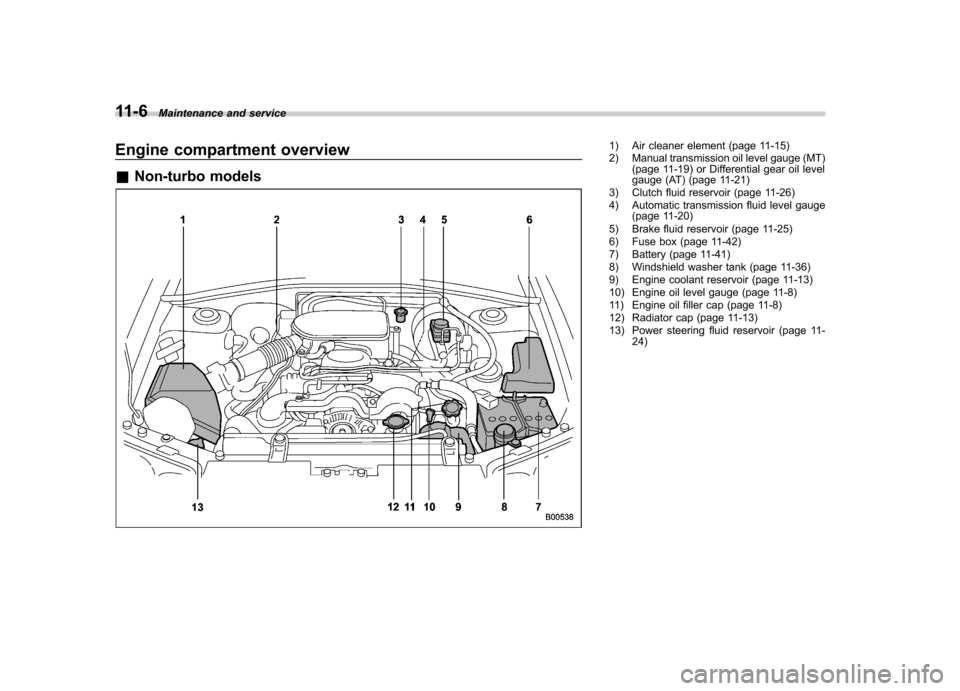2007 SUBARU IMPREZA WRX fuse box
[x] Cancel search: fuse boxPage 16 of 364

14 &Instrument panel
1) Door locks (page 2-4)
2) Outside mirror switch (page 3-33)
3) Light control lever (page 3-22)
4) Combination meter (page 3-6)
5) Wiper control lever (page 3-26)
6) Hazard warning flasher switch (page 3-6)
7) Audio (page 5-1)
8) Gear shift lever (5MT) (page 7-11)/
Gear shift lever (6MT) (page 7-9)/
Selector lever (AT) (page 7-15)
9) Climate control (page 4-1)
10) Cruise control (page 7-26)
11) Horn (page 3-35)
12) SRS airbag (page 1-35)
13) Tilt steering (page 3-35)
14) Fuse box (page 11-42)
15) Hood lock release knob (page 11-4)
16) Power windows (page 2-18)
Page 257 of 364

1) Tread wear indicator bar
2) Indicator location mark
. When the wear indicator appears on
the tread, replace the tire. . The temporary spare tire must be used
only on a rear wheel. If a front wheel tire
gets punctured, replace the wheel with a
rear wheel and install the temporary spare
tire in place of the removed rear wheel.1) Spare fuse
2) FWD connector
NOTE
Before driving your vehicle (if your
vehicle is AWD with automatic trans-
mission, except Turbo models) with the
temporary spare tire, put a spare fuse
inside the FWD connector in the main
fuse box located in the engine com-
partment and confirm that the All-
Wheel Drive warning light “AWD ”in
the combination meter comes on. The
All-Wheel Drive capability of the vehi-
cle has now deactivated. After re-
installing the conventional tire, remove
the spare fuse from the FWD connector
in order to reactivate All-Wheel Drive.
WARNING
Never tow a trailer when the tem-
porary spare tire is used. The tem-
porary spare tire is not designed to
sustain the towing load. Use of the
temporary spare tire when towing
can result in failure of the spare tire
and/or less stability of the vehicle
and may lead to an accident.
CAUTION
Never use any temporary spare tire
other than the original. Using other
sizes may result in severe mechan-
ical damage to the drive train of yourvehicle. In case of emergency
9-3
Page 282 of 364

11-6Maintenance and service
Engine compartment overview &Non-turbo models1) Air cleaner element (page 11-15)
2) Manual transmission oil level gauge (MT)
(page 11-19) or Differential gear oil level
gauge (AT) (page 11-21)
3) Clutch fluid reservoir (page 11-26)
4) Automatic transmission fluid level gauge (page 11-20)
5) Brake fluid reservoir (page 11-25)
6) Fuse box (page 11-42)
7) Battery (page 11-41)
8) Windshield washer tank (page 11-36)
9) Engine coolant reservoir (page 11-13)
10) Engine oil level gauge (page 11-8)
11) Engine oil filler cap (page 11-8)
12) Radiator cap (page 11-13)
13) Power steering fluid reservoir (page 11- 24)
Page 283 of 364

&Turbo models1) Air cleaner element (page 11-15)
2) Manual transmission oil level gauge (MT)
(page 11-19) or Differential gear oil level
gauge (AT) (page 11-21)
3) Automatic transmission fluid level gauge (page 11-20)
4) Clutch fluid reservoir (page 11-26)
5) Brake fluid reservoir (page 11-25)
6) Fuse box (page 11-42)
7) Battery (page 11-41)
8) Windshield washer tank (page 11-36)
9) Engine oil filler cap (page 11-8)
10) Engine coolant reservoir (page 11-13)
11) Engine oil level gauge (page 11-8)
12) Radiator cap (page 11-13)
13) Power steering fluid reservoir (page 11- 24)Maintenance and service
11-7
Page 318 of 364

11-42Maintenance and service
1) Cap
2) Upper level
3) Lower level
It is unnecessary to periodically check the
battery fluid level or periodically refill with
distilled water.
However, if the battery fluid level is below
the lower level, remove the cap. Fill to the
upper level with distilled water.
CAUTION
Never use more than 10 amperes
when charging the battery because
it will shorten battery life. Fuses
CAUTION
Never replace a fuse with one hav-
ing a higher rating or with material
other than a fuse because serious
damage or a fire could result.
The fuses are designed to melt during an
overload to prevent damage to the wiring
harness and electrical equipment. The
fuses are located in two fuse boxes.
One is located under the instrument panel
behind the coin tray on the driver ’s seat
side.
To remove the coin tray, open the cover
and pull the coin tray out.
The other one is housed in the engine compartment.
Page 319 of 364

The spare fuses are stored in the main
fuse box cover in the engine compart-ment.
The fuse puller is stored in the main fuse
box in the engine compartment.
1) Good
2) Blown
If any lights, accessories or other electrical
controls do not operate, inspect the
corresponding fuse. If a fuse has blown,
replace it.
1. Turn the ignition switch to the “LOCK ”
position and turn off all electrical acces- sories.
2. Remove the cover.
3. Determine which fuse may be blown.
The back side of each fuse box cover andthe “Fuses and circuits ”section in chapter
12 in this manual show the circuit for eachfuse.4. Pull out the fuse with the fuse puller.
5. Inspect the fuse. If it has blown,
replace it with a spare fuse of the samerating.
6. If the same fuse blows again, this
indicates that its system has a problem.
Contact your SUBARU dealer for repairs. Maintenance and service
11-43
Page 320 of 364

11-44Maintenance and service
Main fuse
Main fuse box
The main fuses are designed to melt
during an overload to prevent damage to
the wiring harness and electrical equip-
ment. Check the main fuses if any
electrical component fails to operate (ex-
cept the starter motor) and other fuses are
good. A melted main fuse must be
replaced. Use only replacements with the
same specified rating as the melted main
fuse. If a main fuse blows after it is
replaced, have the electrical system
checked by your nearest SUBARU dealer. Installation of accessories
Always consult your SUBARU dealer
before installing fog lights or any other
electrical equipment in your vehicle. Such
accessories may cause the electronic
system to malfunction if they are incor-
rectly installed or if they are not suited for
the vehicle.
Page 357 of 364

14-4Index
Driver ’s Control Center Differential ............................... 7-12
Auto indicator light ................................................. 3-20
Indicator light ......................................................... 3-21
Driving All-Wheel Drive vehicle ........................................... 3-19
Car phone/cell phone .................................................. 7
Drinking ..................................................................... 6
Drugs ........................................................................ 6
Foreign countries ..................................................... 8-4
Pets .......................................................................... 7
Snowy and icy roads ................................................ 8-9
Tips........................................................ 7-10, 7-12, 8-5
Tired or sleepy. ........................................................... 7
E
Electrical system ........................................................ 12-3
Electronic Brake Force Distribution (EBD) system ........................................................... 3-18, 7-23
Emergency Locking Retractor (ELR) ............................. 1-11
Engine Compartment overview ........................................... 11-6
Coolant ................................................................ 11-13
Exhaust gas (Carbon monoxide) ............................ 6, 8-2
Hood .................................................................... 11-4
Oil........................................................................ 11-8Overheating .......................................................... 9-11
Starting ................................................................... 7-7
Stopping ................................................................. 7-8
Exterior care .............................................................. 10-2 F
Flat tires
..................................................................... 9-4
Floor mat .................................................................... 6-9
Fluid level Automatic transmission ......................................... 11-20
Brake .................................................................. 11-25
Clutch ................................................................. 11-26
Power steering ..................................................... 11-24
Front
Differential gear oil ................................................ 11-21
Fog light .............................................................. 11-49
Seatbelt pretensioners ............................................ 1-19
Seats ..................................................................... 1-2
Turn signal light .................................................... 11-49
Fuel ........................................................................... 7-2
Economy hints ........................................................ 8-2
Filler lid and cap ...................................................... 7-4
Gauge ............................................................ 3-8, 3-12
Requirements ......................................................... 7-2
Fuses ..................................................................... 11-42
Fuses and circuits ...................................................... 12-6
G
GAWR (Gross Axle Weight Rating) ............................... 8-14
Glove box ................................................................... 6-4
GVWR (Gross Vehicle Weight Rating) ... ........................ 8-14
H
Hazard warning flasher .......................................... 3-6, 9-2
Head restraint adjustment ............................................. 1-4
Rear ...................................................................... 1-7